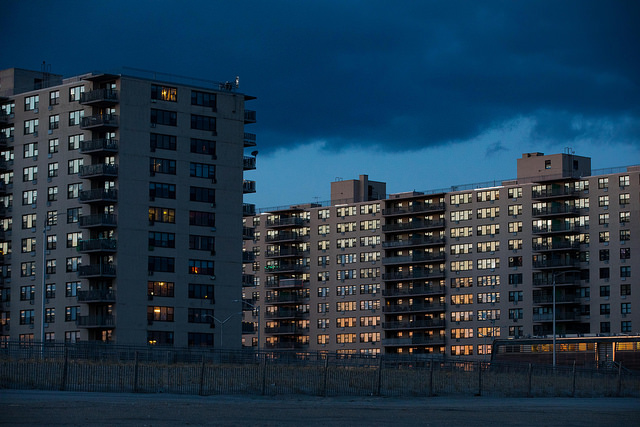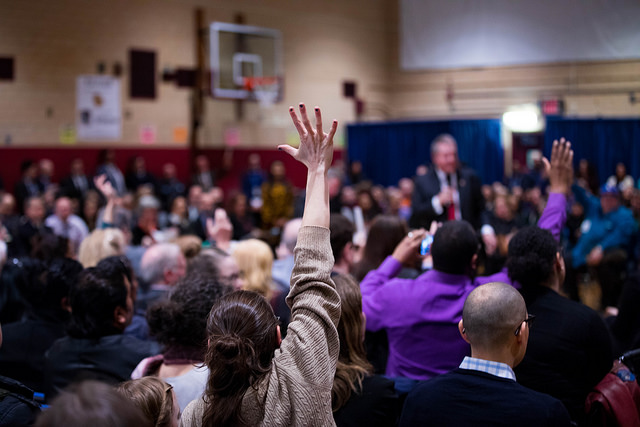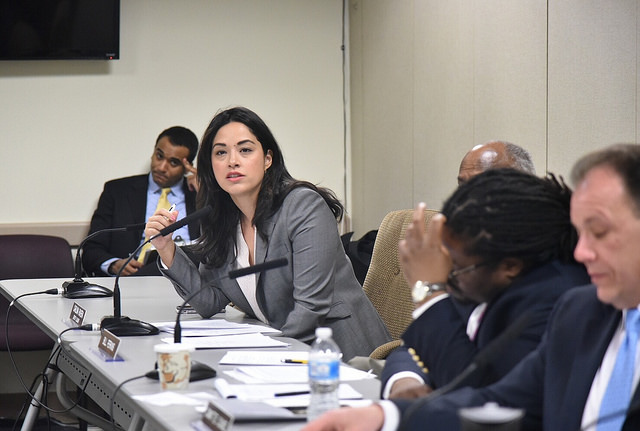To Make New York City More Affordable, End the Cap on Density

(Benjamin Kanter/Mayoral Photo Office)
New York’s severe housing crisis can be traced to a simple fact—our city doesn’t have enough homes for the people who want to live here. The shortage has led to ever-increasing rents, the steady displacement of long-standing communities, and levels of homelessness not seen since the Great Depression. To put it bluntly, we need to build more homes. Lots of them. Affordable and market rate. Yesterday.
One senseless obstacle to new housing is a statewide cap on the density of new residential construction. Since 1961, New York has prohibited the construction of any residential building that has floor space greater than 12 times the size of its lot. This limit is ill-suited for New York City, which needs to allow larger residential buildings to house its growing population in neighborhoods with good transit and good schools. The Regional Plan Association, a respected and nonpartisan think tank, has called for the repeal of this cap, arguing that without more dense construction, displacement in gentrifying neighborhoods will accelerate and the City will choke on worsened congestion.
It is encouraging that Mayor de Blasio and the state Senate have signaled support for ending these restrictions. Unfortunately, Andrew Berman, Executive Director of The Greenwich Village Society for Historic Preservation (GVSHP), recently published an op-ed with Gotham Gazette that includes several misleading arguments in favor of the density cap. Berman argues that fighting against new housing will somehow result in a more affordable city. He is mistaken; while new highrises will not single-handedly fix New York’s affordability problem, they deserve to be recognized as a serious tool for addressing the housing crisis.
In a shortage, the rich, whether they be landlords, wealthy tenants, or homeowners, always win. In a housing glut, tenants win. Denser buildings would produce more housing units, a substantial portion of which would be permanently affordable through the Mandatory Inclusionary Housing law. Before leaving office in 2016, the Obama Administration published an analysis of the barriers to new construction of affordable housing, and the most destructive factor they identified were burdensome restrictions on the size and shape of new buildings, like those Mr. Berman endorses.
Many readers may be skeptical of the idea that new market-rate homes help keep rents low, but studies have shown that denser, market-rate apartments in in-demand neighborhoods relieve pressure on existing homes citywide. Recent construction has lowered median rents across Brooklyn, Manhattan, and Queens, not just the top of the market. And south of 96 Street, the most affordable neighborhoods also happen to be the densest—the Upper East Side and the Lower East Side—and not, tellingly, neighborhoods hemmed in by ‘historic’ zoning, like Mr. Berman’s Greenwich Village.
If we don't produce enough new market-rate units, the people who might move into a new condo building in Downtown Brooklyn might instead buy a converted brownstone In Crown Heights, displacing existing Crown Heights residents in the process. People who might want to live on the Upper West Side are priced out and move into West Harlem instead. Forbidding dense development in one neighborhood is a recipe for gentrification in the next one over. Members of my organization, Open New York, have experienced this first-hand. Some of us, priced out of neighborhoods like Kips Bay, have become reluctant gentrifiers of Bushwick or Bed-Stuy. Others, like myself in the East Village, worry about our rents rising and facing the same fate.
Although unscrupulous landlords or rapacious speculators hardly help matters, the unfortunate truth is that the city’s housing crisis and the displacement it has wrought are primarily caused by these kinds of restrictions. Wealthy and politically-connected residents in desirable neighborhoods consistently use these laws to thwart the construction of new housing under the guise of ‘preserving neighborhood character,’ keeping their communities exclusive and pushing both new residents and their communities’ most vulnerable residents into less well-off areas. The result is gentrification and skyrocketing rents. New York needs to consider another way.
Lifting the state density cap would not affect residents’ right to have a say in new development. Any changes to a neighborhood’s zoning would still have to go through the regular land-use process and be approved by the City Council, and the city’s Mandatory Inclusionary Housing law would still apply, ensuring any changes include a mix of affordable and market rate units. But eliminating the ban would give residents more flexibility to decide how to grow, whereas keeping it forces us to double down on the same failed policies of exclusion. Rather than looking to Greenwich Village—one of the most expensive neighborhoods in the city—as a model to emulate, we should be working to eliminate the barriers to affordable growth. Removing this counterproductive restriction on density is a good first step.
***
William Thomas is an East Village resident and a member of Open New York, an independent pro-housing advocacy group. On Twitter, @OpenNYForAll.
***
Have an op-ed idea or submission for Gotham Gazette? Email This email address is being protected from spambots. You need JavaScript enabled to view it.
Change the Political Status Quo: Run for County Committee

(photo: NYC Mayor's Office)
Today, throughout Kings County, aka Brooklyn, there are many low-income tenants, working class people, and people of color in desperate need of and clamoring for true progressive political representation in their Democratic Party and from their state representatives. Leaders throughout a number of communities are critically looking at our elected officials -- especially state-level politicians running in primary elections this year -- and asking if those officials truly represent their views.
Locally-focused, civic-minded Brooklynites are questioning whether these politicians show up to important meetings or rallies that involve our public schools, our rent-stabilized housing units, our transportation system, and more -- and whether they deliver on those key issues when representing our neighborhoods.
I often scratch my head and wonder why newly-founded groups like New York Senate District 17 for Progress and Rise & Resist,as well as some longer-standing groups like New Kings Democratsexist. And I often arrive at the same clear conclusion: they exist because they’re tired of having centrist politicians representing them and their communities; they want their more left-leaning views represented in government. They want to hold their representatives accountable to the stances that they care about, and they’re fed up with the closed processes of our county system.
Every county in the United States has committees of Democrats and Republicans that help to determine the agenda and endorsements of their local parties. In Brooklyn, there are 21 Assembly Districts that altogether make up the Kings County Democratic Committee. Each Assembly District has many election districts (each of which consists of a roughly three-to-four square-block radius) and Democrats can choose to gather an estimated 40 petition signatures every two years to join the county committee and help mold the platform of their party.
Today, the leaders of our Kings County Democratic Committee could play a huge part in giving the voiceless a voice by expanding the party and ensuring that Democrats from each election district have a say in how they want to be represented through party leadership and what policies the Democratic Party fights for. Unfortunately, this is far from the reality.
Why is it that in the 21st century in the fourth-largest county in the country -- Brooklyn -- there are still about 500 Democratic County Committee seats open? Is it not the function of our local Democratic Party to build our party and ensure inclusion of many voices as we determine the direction we want our party to take when endorsing candidates or crafting policy platforms? There is a key solution for solving this problem: we must organize to reform our party and hold elected officials accountable to our progressive priorities.
Next month, in June, I along with more than a dozen other long-standing Bushwick residents and activists will be petitioning to get on the Kings County Democratic Committee in our Assembly District (AD54). Others should do the same where they live. This includes knocking on doors and collecting roughly 40 signatures of registered Democrats in a four-to-five block radius of your home, depending on the exact map of your election district.
Door-knocking allows for honest conversation with our neighbors about why we’re doing this. We’re tired of having a Democratic Party that is not doing the utmost to push the envelope on things that matter to us. In Bushwick that means fighting the everyday displacement taking place and strengthening schools that have been ranked in the bottom third since state testing has been used as a performance measure.
I am proud to state that these new groups of individuals running for County Committee in AD54 are community board members, organizers, educators, community gardeners, and low- to middle-class tenants. This is important at a time when many progressive organizations in Brooklyn are being dismissed because of how heavily white their memberships appear to be. As a group, we are tired of business-as-usual politics. We are tired of not seeing our Assembly member and state senator at important local meetings. We are tired of progressivism not being the mantle on our table.
As a result, we’ll aim to get some of our very own neighbors to also join County Committee during our door-knocking adventures so we can further build voting blocs that hold our elected officials accountable. It is time for us to be the change we wish see in our local Democratic Party. It is time for us Brooklynites to join en masse and bust open the closed doors of the Kings County Democratic Party.
***
Boris Santos is a community organizer for the office of City Council Member Antonio Reynoso and a former public school teacher. The opinions expressed here are his alone.
***
Have an op-ed idea or submission for Gotham Gazette? Email This email address is being protected from spambots. You need JavaScript enabled to view it.
Expanding Health Insurance Enrollment Will Help Heal New Yorkers and Our Public Hospitals

Council Member Rivera, one of the authors (photo: John McCarten/City Council)
Even in an era of relentless attack on health care by the Trump administration and its allies in Congress, New York City is continuing to reap enormous benefits from the Affordable Care Act. This year alone another 80,000 city residents enrolled in health coverage through our state’s Obamacare exchange.
But a huge number are still being left behind: an estimated 962,000 adults in the five boroughs remain uninsured. These New Yorkers -- many of whom are living in poverty -- often receive no health care until their conditions are severe enough to land them in the emergency room.
The trend is not good for those New Yorkers’ health, as they should have access to preventive care, regular check-ups, and other aspects of quality health care. What’s more, the current situation is also dealing a serious financial blow to our struggling public hospital system (known as Health + Hospitals), whose vital mission it is to serve those in need, including the uninsured. For H+H to avoid financial disaster we need to close the health insurance gap in New York City.
H+H serves over a million patients per year in a network of 11 acute care hospitals and dozens of other facilities throughout the five boroughs. These institutions are by far our city’s largest provider of care to Medicaid recipients, mental health patients, and -- critically -- those who are uninsured.
For decades our public hospitals -- Bellevue, Kings County, Harlem, Elmhurst and others -- have been the ultimate safety net for New Yorkers with nowhere else to turn. H+H’s diverse and committed staff, its proximity to low-income communities, and its sliding-scale fees have helped establish it as second-to-none in serving the neediest New Yorkers.
But balancing the books at our public hospitals has never been easy, in part because Medicaid reimbursement rates are so low. The system’s challenges have only gotten worse in recent years as federal and state safety-net funding has shrunk. And now tectonic changes in the health sector have dealt further blows, as care rapidly moves from inpatient to outpatient services.
The result: H+H is confronting a $1.3 billion deficit this year, projected to balloon to $2.1 billion next year.
This financial strain has real implications for patients, compounding long-running problems in the system. The wait time for appointments at H+H can stretch into the months. Many of the system’s buildings are crumbling, with leaking roofs at Harlem Hospital, deteriorated plumbing at Lincoln, obsolete electric systems at Metropolitan, and elevators throughout the system that are so outdated that their replacement parts are no longer sold.
H+H’s new CEO, Dr. Mitchel Katz, has laid out a multi-pronged plan to address this crisis. He has set out to reduce administrative expenses, more effectively bill insurance companies, and retain more paying patients, among other efforts.
But there is another critical strategy needed to save H+H: New York City urgently needs to enroll more people in health insurance.
Our public hospitals treat over 400,000 uninsured patients each year. That represents hundreds of millions of dollars of lost insurance billing for those eligible for coverage. Providing this health care regardless of ability to pay is the moral thing to do. It also affects the health of all New Yorkers by helping us prevent the spread of communicable diseases.
We need to tap health insurance as a way to make this important work financially sustainable. That’s why it’s critical that we dramatically ramp up our outreach and enrollment efforts.
Today, most funding for ACA enrollment is provided by the State, which spends about $12 million per year on a network of community-based organizations in the five boroughs offering health insurance navigation assistance.
Several City agencies also have dedicated teams doing enrollment, but the numbers are small: only about 50 staff at Human Resources Administration (HRA) and 70 at Department of Health and Mental Hygiene (DOHMH).
We need an aggressive, coordinated plan to take this work to the next level. And we need to be on the ground in neighborhoods. Community-based non-profits make ideal partners for this work, because of their cultural competence and because of the trust they so often have earned in low-income communities.
One group of New Yorkers can’t get enrolled no matter how much we spend on outreach: undocumented immigrants. But there’s a win-win possibility for them as well. By investing in a program to provide them access to primary care we can improve health outcomes and prevent the more costly H+H emergency room admissions that would otherwise occur.
A twin effort to enroll more New Yorkers who are eligible for insurance and to fund access to primary care for those who are undocumented would improve the health of our people while going a long way to shore up the finances of our public hospital system.
That would be a giant step forward to the goal of ensuring that each and every New Yorker, regardless of income or immigration status, has access to the affordable, high-quality care they need.
***
Mark Levine and Carlina Rivera are members of the New York City Council. Levine chairs the Council’s health committee, Rivera chairs its hospitals committee. On Twitter @MarkLevineNYC and @CarlinaRivera.
***
Have an op-ed idea or submission for Gotham Gazette? Email This email address is being protected from spambots. You need JavaScript enabled to view it.




